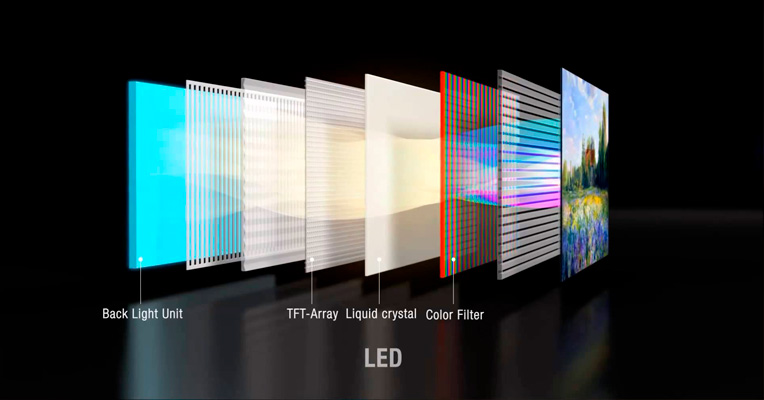At this point in time, virtually all displays on any kind of device that requires one have either a LED or LCD display. With many devices now offering interactivity and internet connectivity, displays of some kind are most often a necessity. Be it your television set, computer monitor, smartphone, tablet, watch, or other smart devices in your home, it most likely has a thin, flat screen, which is the hallmark of both LED and LCD displays.
On some devices, namely computers and monitors, the display is the single most important aspect of the device. When looking for which device to buy, and finding which type would serve a person’s needs the most, it may be confusing to understand the differences between LED and LCD displays. If you fall into this category, then read on for a comprehensive and informative look at both display technologies.
LCD Technology
LCD, short for Liquid Crystal Display, is a kind of display technology that has become the standard for most monitors and televisions. LCD displays consist of liquid crystals that are trapped between two polarizing filters and use electrical currents to rearrange the crystals in patterns that allow for the blockage and flow of light to produce images.
LCD technology has existed for many years, with the underlying technology first discovered in the 1880s. However, it wasn’t until the 1960s that LCD technology was first invented for use as a type of display technology. Shortly after this invention, many types of small LCD displays were created for use in multiple types of devices, ranging from watches and calculators to alarm clocks and instrument panels.
LCDs provided a much smaller footprint and required considerably less power to operate than many other types of technologies, with it becoming widely used in many consumer electronics products in the 1980s. In this same decade, the very first computer and laptop monitors were created, utilizing monochrome (two color) displays with passive matrix technology. These displays were often less than ideal, with slow refresh rates and mostly offering just two color images and text, but required much less electricity to use and required far less space than the typical CRT displays of the time.
By the 1990s, color LCD displays started coming into use, first utilizing the slower and less expensive passive matrix technology, which had a slow refresh rate and often dim or faded colors. However, by the turn of the millennium, active matrix LCD displays fell drastically in price and became much more common, and by 2007, LCD televisions were outselling CRT TVs. In only a few short years since then, LCD displays have almost completely supplanted CRTs as the most common display technology.
LCD: How Does It Work?
The basic technology behind an LCD display is a thin liquid substance that is trapped between two polarizing layers, that utilizes electric currents to arrange the crystals in the liquid to allow or block the flow of light that is emitted behind them. Lighting for LCD displays is commonly provided by thin fluorescent lamps that are placed at various points behind the display.
The liquid is arranged in very small compartments that compose the pixels of a display, with many modern displays having millions of pixels. Electric currents are run through each pixel, utilizing the polarizing layers to arrange the pixels to block lighting at various degrees, allowing for the appearance of both dark and bright colors, with thousands of shades in between.
Two main types of LCD technology were very common in the early years, known as passive matrix and active matrix. Most monitors from the early to mid-1990s utilized the cheaper but slower passive matrix technology, but by the early 2000s, active matrix screens became the standard. By now, active matrix technology is the standard on all televisions and monitors, with passive matrix only used on small, cheap displays that don’t require constant refreshing of the images or data on the screen.
Main Benefits and Disadvantages of LCD Displays
The biggest disadvantages of LCD displays come down to the basic application of the technology. LCDs typically provide slower refresh rates than CRT displays, which means that moving images tend to appear blurred on the screen. LCDs can also often have much more limited viewing angles, which means that sitting off far to the side of the display can result in an image that appears distorted or with missing or wrong colors. One other disadvantage is uneven lighting that can be produced by the fluorescent tubes that emit light behind the display, resulting in some parts of the display appearing brighter than others. Despite these disadvantages, LCD displays are constantly improved and perform much better in these areas than just a few years ago.
LED Technology
LED, short for Light Emitting Diode, is a technology that can be traced back to its original discovery more than 100 years ago. LEDs were created by using electroluminescense within an enclosed glass casing, which allowed for the bright focus of light coming from a small source. Although these were discovered and invented in the early 20th Century, it wasn’t until the 1950s that LEDs were first used in a practical application.
LEDs originally existed as a standalone display technology, used for powering bright displays with a collection of LEDs, usually arranged in a grid pattern, using patterned lighting to create letters, numbers or even basic images. These displays were often used as outdoor advertisements or signs, often replacing neon signs, as they required much less electricity to use and allowed for greater flexibility in what could be displayed. As the years passed, LEDs started shrinking in size, and many of the LED displays became more complex, with many larger incarnations being used in large sports stadiums to display complex images and animations, and smaller ones used to power point of sale terminals or electronic pocket calculators.
With the proliferation of LCD technology in the 1970s through 1990s, LED displays started falling out of use, in favor of LCD displays, which were generally more flexible and required less power to operate. However, by the late 2000s, a new practical use for LEDs was found in the use of display technology, by coupling it with LCD technology. This marriage of the two technologies led to what we now call big screen LED TVs and monitors.
LED: How Does It Work?
Modern LED displays are actually a combination of current LCD displays coupled with very small but powerful LED light emitters, with the main difference between the two being the method of lighting used. Where LCD displays typically use long fluorescent lamps behind the display to emit lighting, LED displays use small LED lights, either along the edges of the display or directly behind the display. The arrangement of LED lighting allows the displays to show truer blacks, with light being more evenly blocked in a dark image. Outside of the lighting, LED displays work in virtually the same way as LCD displays.
Main Benefits and Disadvantages of LED Displays
Since LED displays are very similar to LCDs, they share virtually all of the same advantages as LCDs when compared to the older CRT technology. However, LEDs do offer some advantages over LCD displays, with being able to provide more evening lighting behind the screen, which prevents the problem of LCD displays sometimes having uneven lighting, and also allows for greater viewing angles.
LED displays do have a few small disadvantages when compared to traditional LCD displays. Some of the earlier LED displays were thicker than the typical LCD, largely due to the arrangement of the LEDs inside the display. However, this disadvantage is quickly disappearing, with many of the newer LED displays being both thinner and lighter than their LCD counterparts. LEDs also tend to use slightly more electricity than LCD displays, and they tend to age worse, with colors starting to shift over time. LED displays are also typically a bit more expensive than LCDs. Despite these small disadvantages, almost all of them are quickly disappearing with the improvement in LCD and LED display technology.
LED vs LCD: Which One Is Better?
After looking at the differences between LED and LCD displays, and seeing the advantages and disadvantages that both offer, which one is better for you will come down to your basic needs. If you’re in need of a quality display for the most affordable price, then LCD displays are probably your best bet. If you don’t mind paying a little more for the advantages that LED display brings with them, then getting a LED display will be a no-brainer.
Despite the small differences between the displays that have been noted here, in a few short years, you will have less of a choice to make. With the rapid advancements that have occurred in both LED and LCD technology, the differences between the two are becoming more minor. Due to their similarity in how they work, LED and LCD technologies are merging together to bring the best and brightest displays available for an affordable price.








